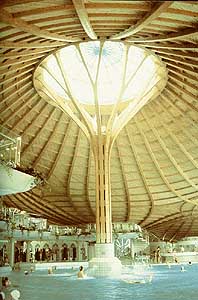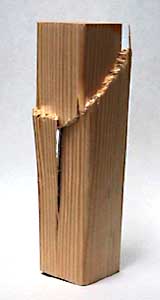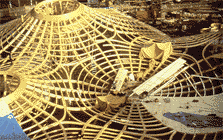| |
| |
|
| |
| |
| |
||
| |
||
| |
||
|
|
|
the Glulam Tree | Bad Dürrheim, Germany
Glued-laminated timber is a structural timber product manufactured by gluing together individual pieces of dimension lumber under controlled conditions, usually in a plant or factory (the term "dimension lumber" is used to refer to cut and surfaced lumber such as 2 x 4, 2 x 6, 2 x 8, etc., or 38 x 89, 38 x 140, and 38 x 184 in the metric system). The attributes of this wood product account for its frequent use as an attractive and versatile architectural and structural building material. Because it is a manufactured product, it is possible to order glulam members for a wide variety of applications and/or configurations. Members meant for wet environments (such as that shown here) can be fabricated using waterproof glues. Curved members of virtually any practical radius are possible simply by forming individual pieces into the desired shape prior to gluing them. Naturally occurring defects such as knots, wanes, and checks in larger-sized timbers can be controlled or eliminated in glulam by using laminations that contain only acceptable flaws. Glulam members are available in much longer lengths and larger sizes than standard sawn timbers, and contractors generally find it relatively easy to do the final preparations for glulam members on site, where accurate measurements can be made.
The strength of a wood member is not only a function of its physical nature, but its organic nature as well. The size and strength of the wood cells and the quality of the lignin between cells are determined by the conditions under which the tree grew; drought or excessive moisture, required nutrients, and insect infestation, to name a few, will all determine the strength of the member, or there may be internal defects, such as knots or pitch pockets. These are some of the factors that give timber its variability, and require engineers to assign relatively high safety factors when designing with wood. The timber specimen pictured above, for example, would only be permitted to support a force of 3,500 pounds, giving it a safety factor of 25,200 ÷ 3,500 = 7.2. In other words, the maximum load an engineer would expect the member to support would be 7.2 times lower than the load it is capable of supporting without failure. However, because of the unpredictable nature and the variability of timber, the safety factor is extremely reasonable, particularly when the chance of damage or loss of life is involved. A material like steel, which is very homogeneous in composition and structure, would have a safety factor of approximately 2, reflecting its predictable nature.
 Click for a larger (42k) graphic Click for a larger (42k) graphicphotos © Julius Natterer, Tom Abbühl |

 Wood, steel, and concrete are the three principal materials utilized by civil engineers when designing structures. Unlike steel and concrete, which are cast and formed, wood is organic, and subject to a great deal more variability in its fundamental properties. Take a block of wood , magnify it, and you'll see what appears to be a bundle of drinking straws glued together; the drinking straws are the tree's cells, bound together with a weak glue called lignin, and they give wood its "grain". Because of this makeup, we say that wood is an "anisotropic material"—it behaves differently in different directions. For example, if you took a bundle of drinking straws, you would find it easy to crush them as a group by pushing against their sides (perpendicular to their length). However, if you pushed against their length (parallel to length), you would find it far more difficult to cause any appreciable sign of failure in the bundle. Wood behaves in an identical manner insofar as crushing is concerned; it is far stronger when loaded parallel to grain than perpendicular to grain. The photograph shows a 150mm x 38mm x 38mm (6" x 1½" x 1½") piece of clear Douglas Fir we tested in one of our labs. It required a force of 25,200 pounds (112 kN) applied parallel to the grain to crush this particular piece—we've had some withstand as much as 28,000 pounds before failing. If, on the other hand, we applied the force perpendicular to grain, it would crush to the point of failure at about 20% of the same load.
Wood, steel, and concrete are the three principal materials utilized by civil engineers when designing structures. Unlike steel and concrete, which are cast and formed, wood is organic, and subject to a great deal more variability in its fundamental properties. Take a block of wood , magnify it, and you'll see what appears to be a bundle of drinking straws glued together; the drinking straws are the tree's cells, bound together with a weak glue called lignin, and they give wood its "grain". Because of this makeup, we say that wood is an "anisotropic material"—it behaves differently in different directions. For example, if you took a bundle of drinking straws, you would find it easy to crush them as a group by pushing against their sides (perpendicular to their length). However, if you pushed against their length (parallel to length), you would find it far more difficult to cause any appreciable sign of failure in the bundle. Wood behaves in an identical manner insofar as crushing is concerned; it is far stronger when loaded parallel to grain than perpendicular to grain. The photograph shows a 150mm x 38mm x 38mm (6" x 1½" x 1½") piece of clear Douglas Fir we tested in one of our labs. It required a force of 25,200 pounds (112 kN) applied parallel to the grain to crush this particular piece—we've had some withstand as much as 28,000 pounds before failing. If, on the other hand, we applied the force perpendicular to grain, it would crush to the point of failure at about 20% of the same load. Returning to the swimming pool complex, the picture at left shows the roof structure during construction. This is a very complex architectural design, and requires both an extremely competent engineer and contractor to bring it to successful completion. In light of the fact that this structure mimics the natural world, it is only fitting that its principal construction material reflect that natural world as well. Hopefully this simple explanation of one of the properties of timber will inspire you to take your knowledge one or more steps further, and we'd be glad to help you in that regard.
Returning to the swimming pool complex, the picture at left shows the roof structure during construction. This is a very complex architectural design, and requires both an extremely competent engineer and contractor to bring it to successful completion. In light of the fact that this structure mimics the natural world, it is only fitting that its principal construction material reflect that natural world as well. Hopefully this simple explanation of one of the properties of timber will inspire you to take your knowledge one or more steps further, and we'd be glad to help you in that regard.